(MENAFN- ProactiveInvestors)
Gold was down 1.72 percent at the end of 2014 but things are looking up for the yellow metal. This week I returned from presenting at the Vancouver Resource Investment Conference where sentiment for gold was through the roof.
And with good reason. Even though gold was down last year it still ranked as the second-best-performing currency following the U.S. dollar. The metal has risen about 10 percent year-to-date and on Tuesday for the first time since mid-August it broke through the $1300 mark.
Are you excited yet
Our two gold funds the Gold and Precious Metals Fund (USERX) and World Precious Minerals Fund (UNWPX)have responded positively to the rally. Both have jumped above their 50-day moving averages a key trend indicator many investors use to decide when to allocate assets.
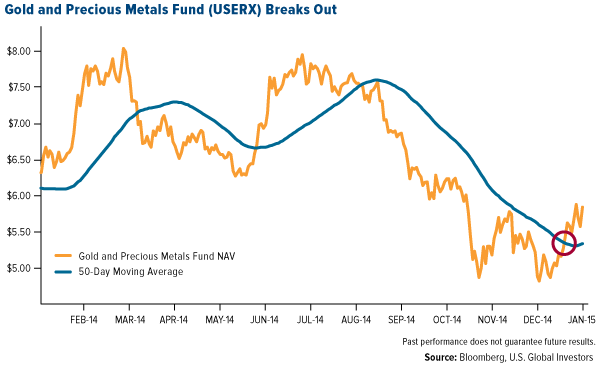
click to enlarge
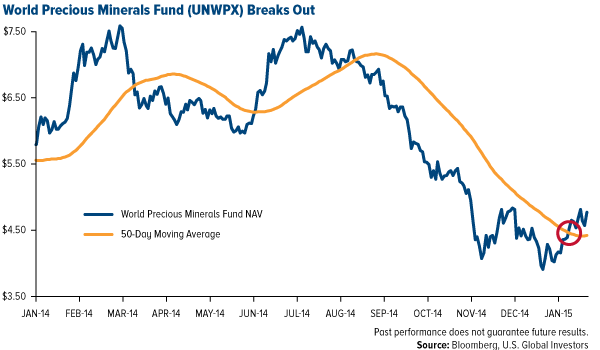
click to enlarge
You’ve probably heard or read that gold’s breakout is a direct result of what’s currently happening in Europe but there’s much more to the story.
To be clear the events I’m referring to are a huge deal and shouldn’t be discounted. As we say at U.S. Global Investors government policy is a precursor to change and certainly gold has struck a musical chord in the world of currency symphonies.
The European Central Bank’s (ECB’s) unveiling of a much-needed trillion-dollar quantitative easing (QE) program will hopefully lead to a stronger economy in the eurozone. For two years now it seems the region has held much of the world hostage with its lack of growth.
Switzerland unexpectedly unpegged its currency the Swiss franc from the euro shocking money managers all over the world. The country also let its 10-year government bond yield sink into negative territory joining Germany Spain and Italy whose yields now hover near record lows. This makes other assets especially gold look much more attractive.
And in Greece the possibility of a far-left anti-austerity Syriza victory in Sunday’s general election could spell the end of the Mediterranean country’s membership in the European Union.
All of these developments have spurred investors to seek safety in gold.
But there’s more at work fueling the metal’s ascent.
Currency Wars
As I’ve discussed many times before the strong U.S. dollar—it’s currently up 2.2 standard deviations for the 10-year period—has not only weighed on crude oil but also caused other global currencies to depreciate. Both have helped many foreign gold producers expand their profit margins as bullion is then able to gain in value more quickly.
“The Canadian dollar has weakened quite a bit against the U.S. dollar for a lot of our gold stocks in Canada” Ralph Aldis portfolio manager of our gold funds explained during our most recent webcast. “These producers benefit when the local currency depreciates.”
This is because they pay their workers in the weaker local currency but sell their bullion in U.S. dollars.
When expressed in Canadian dollars gold has sharply ramped up to a nine-month high:
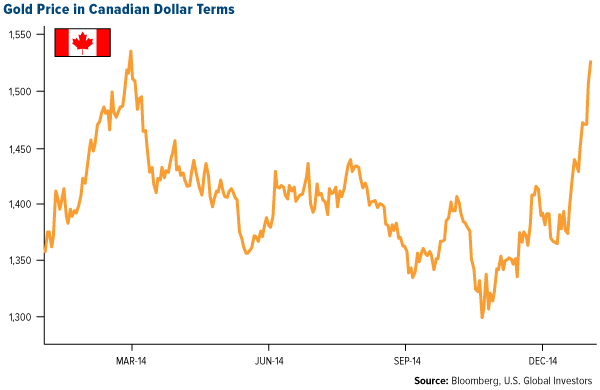
click to enlarge
Gold has also shot upward in Japanese yen and euro terms:
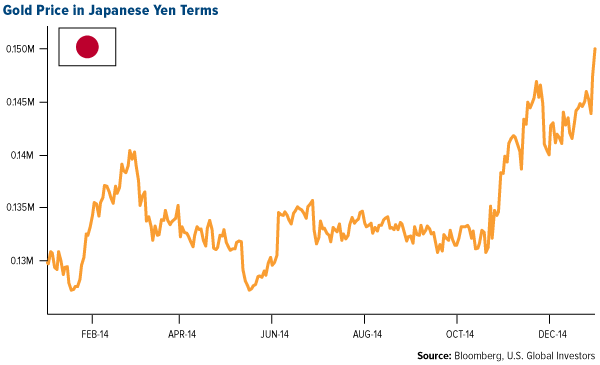
click to enlarge
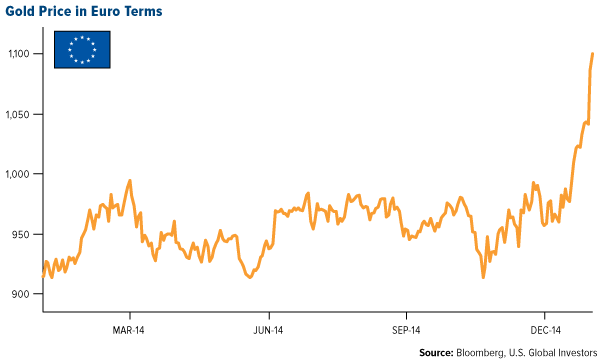
click to enlarge
A weaker South African rand has been a tailwind for two of our South African holdings and Harmony Gold Mining. Below you can see that both companies have broken free of their 50-day moving averages—by a much wider spread than we’ve seen since at least March of last year.
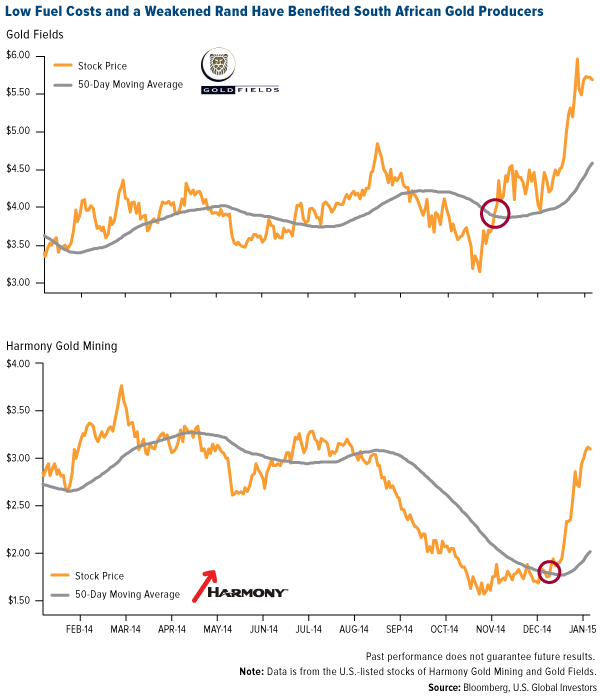
click to enlarge
Then there are falling fuel costs ordinarily gold miners’ biggest expense.
“If you factor in lower energy prices that basically gives companies a double whammy in terms of margin expansion” Ralph said.
Headquartered in Toronto the world’s largest gold producer saves about $25 per ounce on lower diesel expenses according to BullionVault.
Before it started recovering at the beginning of January gold had been pretty banged up since mid-August. As a result companies have slashed capital spending especially the junior miners.
But recently we’ve seen merger and acquisition (M&A) activity in the gold space typically a good sign. In late November Osisko Gold Royalties announced it would buy Quebec City-based for $424 million and now we’ve learned that Vancouver-based will be acquiring precious metals explorer for $440 million. Probe is a relatively new player in the field having made two discoveries in Ontario since 2009.
First of all this makes sense. If you’re looking to expand your company you might as well do it when everything’s on sale. But these M&As also indicate that there’s enough confidence in the future of the precious metals industry to justify such capital spending. It says a lot about the market that would agree to purchase a younger exploration company a move we haven’t seen in a while.
Repatriation Games
This is what largely drives gold demand: confidence in the metal as a store of value in good times and in bad. Gold is much more than a commodity—it’s a form of currency one that “has never required the credit guarantee of a third party” as former Federal Reserve Chair Alan Greenspan made clear in September.
Last year gold was the second-strongest currency in the world trailing only the U.S. dollar. It’s amazing how well it held up under the pressure of the greenback. Not just investors but also central banks recognize this.

“If the dollar or any other fiat currency were universally acceptable at all times” Greenspan said “central banks would see no need to hold any gold. The fact that they do indicates that such currencies are not a universal substitute.”
Indeed we’re seeing central banks all around the world shoring up their own gold reserves by repatriating bullion from foreign institutions. December saw the biggest monthly outflow of gold from the New York Fed since 2001 bringing its holdings to their lowest level this century.
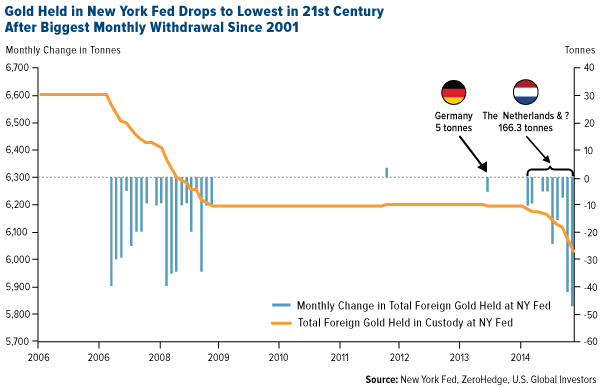
click to enlarge
Central banks might be jittery from global growth concerns—the International Monetary Fund just downgraded its growth forecast for 2015—or simply recognizing the tenuousness of fiat money. Either way the message is resounding: gold is an essential component to a strong portfolio and an excellent store of value.
As always we recommend a 10-percent weighting in gold: 5 percent in bullion 5 percent in gold stocks then rebalancing every year.
I’ll have more to share with you when I return next week from Zurich where I’ll be presenting at its International Business School. Also be sure to catch the weekly episode of Gold Game Film with Kitco News this upcoming Monday. I’ll be conducting the interview from Florida while I attend the Inside ETFs Conference.
Total Annualized Returns as of 12/31/2014 | | One-Year | Five-Year | Ten-Year | Gross Expense Ratio | Expense Cap |
| Gold and Precious Metals Fund (USERX) | -14.00% | -15.67% | 0.38% | 2.15% | 1.90% |
| World precious Minerals Fund (UNWPX) | -16.52% | -18.79% | -2.57% | 1.86% | N/A |
Expense ratios as stated in the most recent prospectus. The expense ratio after waivers is a voluntary limit on total fund operating expenses (exclusive of any acquired fund fees and expenses performance fees taxes brokerage commissions and interest) that U.S. Global Investors Inc. can modify or terminate at any time which may lower a fund’s yield or return. Performance data quoted above is historical. Past performance is no guarantee of future results. Results reflect the reinvestment of dividends and other earnings. For a portion of periods the fund had expense limitations without which returns would have been lower. Current performance may be higher or lower than the performance data quoted. The principal value and investment return of an investment will fluctuate so that your shares when redeemed may be worth more or less than their original cost. Performance does not include the effect of any direct fees described in the fund’s prospectus (e.g. short-term trading fees of 0.05%) which if applicable would lower your total returns. Performance quoted for periods of one year or less is cumulative and not annualized. Obtain performance data current to the most recent month-end at www.usfunds.com or 1-800-US-FUNDS.
Index Summary
- The major market indices finished higher this week. The Dow Jones Industrial Average rose 0.92 percent. The S&P 500 Stock Index gained 1.60 percent while the Nasdaq Composite advanced 2.66 percent. The Russell 2000 small capitalization index rose 1.04 percent this week.
- The Hang Seng Composite rose 2.35 percent; Taiwan gained 3.64 percent and the KOSPI advanced 2.54 percent.
- The 10-year Treasury bond yield fell 4 basis points to 1.79 percent.
Domestic Equity Market
The S&P 500 gained 1.60 percent this week as financial markets around the globe responded positively to the “shock and awe” quantitative easing (QE) announcement by the European Central Bank (ECB). Global liquidity will remain robust as central banks inject more capital into the global financial system. Cyclical areas of the market outperformed due to the expected improving economic outlook expected in Europe and around the world. In response to the ECB’s actions other central banks also took action to ease monetary policy. In many ways this was a defensive reaction to what has been termed a currency war but the implications should be positive for global financial assets.
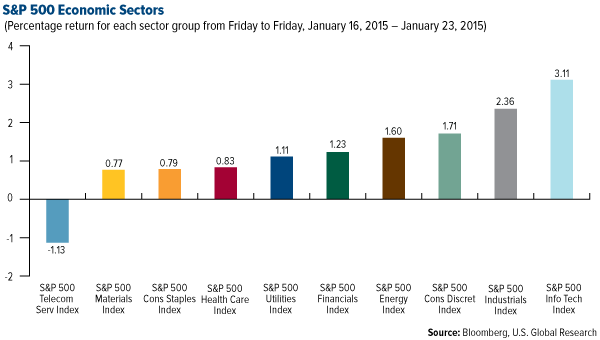
click to enlarge
Strengths
- The technology sector was the best performer this week with bouncing back 6.76 percent and recovering some of the recent sell-off post earnings. and also rose by more than 6 percent this week which is a likely sign that money was coming back into the market and went to the large liquid and quality names.
- The industrials sector was also a strong performer on the back of strong earnings results from airline names. and Delta Airlines were the best performers in the sector rising 15.96 and 10.30 percent respectively. Lower fuel prices and continued robust industry dynamics were the drivers.
- was the best performing company this week rising 29.68 percent. The company’s earnings report was very well received due to better-than-expected international subscriber growth and comments from the company that it would be profitable in all 200 countries with broadband internet service in two years.
Weaknesses
- The telecommunications services sector was the worst performer this week as Verizon posted a slight earnings miss dragging the group lower. AT&T is set to report next week.
- The air freight and logistics group was also an underperformer this week. UPS fell almost 10 percent on Friday as the company unexpectedly warned that the fourth-quarter profit would be below expectations on higher costs.
- The worst performing company this week was which fell 9.06 percent. The company reported quarterly revenue that was below expectations and failed to reassure investors that the second quarter would be better.
Opportunities
- After outperforming in 2014 defensive stocks may be poised to continue this positive movement. The appears intent on normalizing monetary policy and the bond market is responding by sending long-term yields lower. This implies that the market believes a tighter Fed will materially slow down the economy.
- Earnings season will kick into high gear next week .Some key companies to keep an eye on include and Biogen IDEC.
- If oil can find a bottom and move higher small and mid-cap energy stocks would be among the first beneficiaries.
Threats
- The rally in U.S. energy producers may be short lived as OPEC countries seem to be acting individually rather than as a collective cartel. This move makes predicting future actions more difficult but is positive for the inverse beneficiary companies in sectors such as airlines and consumer discretionary.
- The meets next Wednesday and if the recent hawkish tone remains the market may not respond positively.
- Earnings season got off to a rough start with large-cap financials disappointing and while the past week was better it wasn’t resoundingly so. If the market is looking for an excuse after such steady performance for the past year a lackluster earnings season may be the catalyst for that 10-percent correction it’s been bracing for (but which has yet to materialize for more than two years).
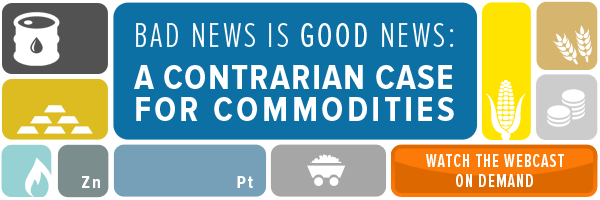
The Economy and Bond Market
U.S. Treasury bonds were mixed this week with short-term bond yields flat-to-up and longer-term yields falling. The European Central Bank (ECB) moved aggressively in implementing a much-awaited quantitative easing (QE) program. The concern going into the meeting was that the ECB would disappoint the market but the bank pulled out all the stops and announced what is in effect an open-ended policy to purchase 60 billion euros of European government debt per month. This announcement sent bond yields lower in Europe and ignited a U.S. dollar rally.
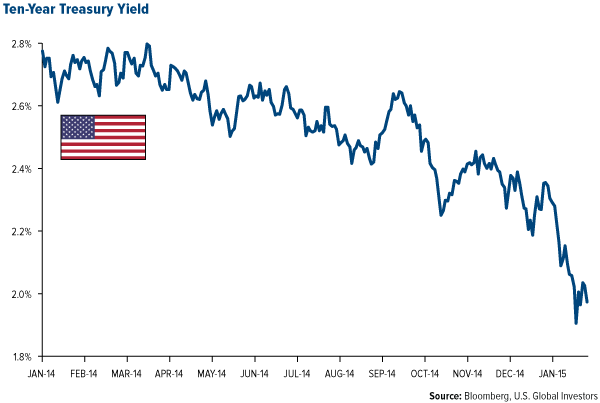
click to enlarge
Strengths
- Global central bankers fearful of falling into a deflationary trap continue to act aggressively and implement easing monetary policies.
- German investor confidence soared in January according to the ZEW survey. The survey hit the highest level since February 2014.
- Housing starts for December were better than expected and weekly mortgage applications are surging on falling mortgage rates.
Weaknesses
- The HSBC China manufacturing flash purchasing managers’ index (PMI) rose in January but still remains in contraction territory.
- The International Monetary Fund reduced its 2015 global growth forecast to 3.5 percent from 3.8 percent.
- Chinese economic data remains relatively muted as GDP growth in 2014 was at the slowest level in 24 years rising 7.3 percent.
Opportunities
- The European Central Bank delivered this week on its QE announcement and other countries around the world responded by cutting interest rates or implementing other easing policies.
- The meets again next week and while it has continued to emphasize a preference to raise interest rates by mid-year the strong dollar and rapidly falling inflation expectations may make the Fed backtrack a bit. If this move were to happen the short end of the yield curve would likely rally.
- Municipal bonds continue to look like an attractive alternative in the broad fixed-income universe.
Threats
- Greece is generating negative headlines again and while this appears to be an isolated political event it does reinforce the idea of the potentially fragile nature of the euro currency. Greek elections are this Sunday January 25.
- Oil prices appear to be extremely oversold. A bounce in oil could change the mood throughout the market and bonds could sell off in reaction.
- The Fed’s next meeting is set for January 28 and if the hawkish tone continues the market could be spooked.

Gold Market
For the week spot gold closed at $1294.49 up $14.04 per ounce or 1.10 percent. Gold stocks as measured by the NYSE Arca Gold Miners Index lost 1.23 percent. The U.S. Trade-Weighted Dollar Index gained 2.60 percent for the week.
| Date | Event | Survey | Actual | Prior |
| Jan 19 | China Retails Sales YoY | 11.70% | 11.90% | 11.70% |
| Jan 20 | Germany ZEW Survey Current Situation | 13 | 22.4 | 10 |
| Jan 20 | Germany ZEW Survey Expectations | 40 | 48.4 | 34.9 |
| Jan 21 | U.S. Housing Starts | 1040K | 1089K | 1028K |
| Jan 22 | ECB Main Refinancing Rate | 0.05% | 0.05% | 0.05% |
| Jan 22 | China HSBC China Manufacturing PMI | 49.5 | 49.8 | 49.6 |
| Jan 27 | Hong Kong Exports YoY | 3.00% | - | 0.40% |
| Jan 27 | U.S. Durable Goods Orders | 0.40% | - | 0.70% |
| Jan 27 | U.S. New Home Sales | 450K | - | 438K |
| Jan 27 | U.S. Consumer Confidence Index | 95.5 | - | 92.6 |
| Jan 28 | U.S. FOMC Rate Decision (Upper Bound) | 0.25% | - | 0.25% |
| Jan 29 | U.S. Initial Jobless Claims | 300K | - | 307K |
| Jan 30 | Euro Core YoY | 0.70% | - | 0.70% |
| Jan 30 | U.S. GDP Annualized QoQ | 3.10% | - | 5.00% |
Strengths
- Gold prices topped $1300 per ounce for the first time in five months on Thursday. As a result gold traders were bullish for an eighth week citing safe-haven demand stemming from the weaker euro as well as inflows into exchange-traded funds.
- Russia the world’s fifth biggest holder of gold boosted reserves for a ninth month in December while its reserves jumped the most in six months. The country has more than tripled its gold reserves since 2005 and holds the most since at least 1993. The precious metal accounts for about 11 percent of Russia’s total foreign reserves.
- After a 47-year absence the British Royal Mint is bringing back gold and silver bars bearing the mint’s historic refinery brand. The Royal Mint Refinery dates back to 1852 and was operated by N.M. Rothschild and Sons. Silver bars will be available in 100-gram units while gold bars will be offered in a variety of sizes ranging from one gram to 100-gram units. The gold bars in particular will be exempt from the value-added tax for British citizens.
Weaknesses
- Germany’s Bundesbank announced that it repatriated 120 tonnes of gold from Paris and New York in 2014. Since the transfers began in 2013 the bank has relocated a total of 157 tonnes. However with Germany being the second biggest holder of gold there is a question as to why the Bundesbank continues to struggle to get its gold reserves back. Previously Germany has been denied requests for gold by New York as well as the opportunity to even view its gold on grounds of “security.” Further adding to this cloud of doubt is the fact that the last audit of the New York Fed took place over 50 years ago.
- The International Monetary Fund made the steepest cut to its global growth forecast in three years in an outlook released on Monday. It said slowing growth almost everywhere except in the U.S. will more than offset the boost to expansion from the slump in oil prices.
- Indian gold importers are offering the widest discount in 17 months versus London prices as jewelers curtail purchases ahead of a possible cut in the import duty. This expectation has been built as a result of a falling trade deficit.
Opportunities
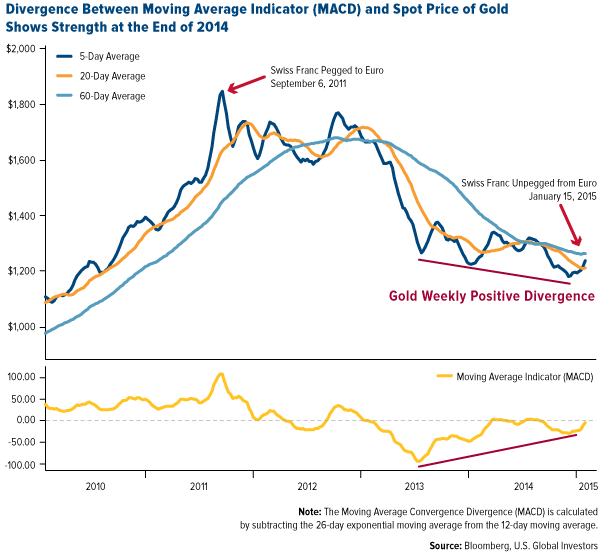
click to enlarge
- The institution of the Swiss National Bank's peg of CHF 1.20 per euro back on September 6 2011 was the day that gold peaked at $1920 per ounce. With the undoing of the peg and gold taking off speculation abounds as to whether the Swiss National Bank's actions will have once again marked a turning point for gold. In addition silver appears to be breaking out too from its historic downtrend as shown in the chart below.
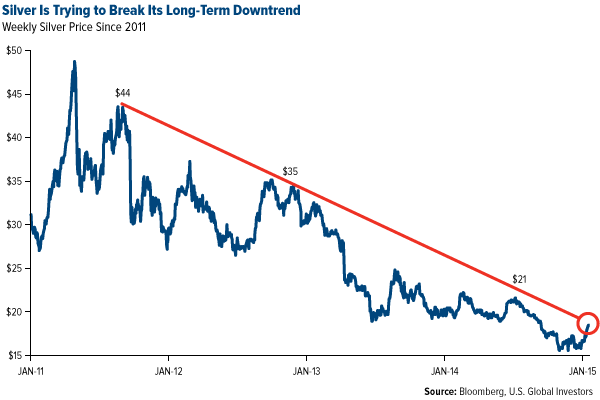
click to enlarge
- In his submission to this year’s London Bullion Market Association’s precious metals forecasting competition Ross Norman who heads up London bullion broker Sharps Pixley is forecasting gold to average $1321 per ounce in 2015. Norman is considered to have been the most successful forecaster in the LBMA panel in the past and has been the winner of the competition five times.
- has announced a takeover bid for junior developer offering a solid premium at the $5 per share offer price. We view this deal as a turning point in the risks mining companies have been willing to take relative to recent transactions. Specifically had previously made a bid for but only after it was completely de-risked relative to perhaps offering to buy or which offered better value and a higher likelihood of earning a superior return on invested capital. Subsequently Silver Standard bought the Marigold Mine while purchased the Wharf Mine from . With Marigold and Wharf having been in production for the past 20 to 30 years development risks were again avoided. This move hopefully falls in line with a recent report published by in which it recommends miners to embrace longer-term thinking get back to basics to clarify what they stand for and what they plan to achieve in the long term.
Threats
- announced that opportunities to short gold are building as recent price gains are unsustainable.
-
Legal Disclaimer:
MENAFN provides the information “as is” without warranty of any kind. We do not accept any responsibility or liability for the accuracy, content, images, videos, licenses, completeness, legality, or reliability of the information contained in this article. If you have any complaints or copyright issues related to this article, kindly contact the provider above.